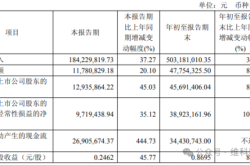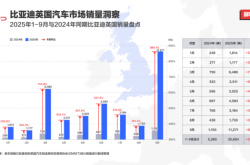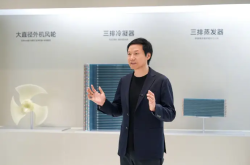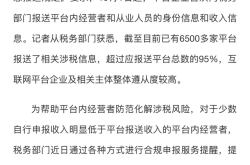The Evolution of Cloud Computing Vendors Two Years into Their AI Strategies
![]() 04/07 2025
04/07 2025
![]() 454
454
If AI was once a "technological bonsai" confined to laboratories, 2024 marks the dawn of large-scale AI implementation, where technology investments and commercial returns have forged a virtuous cycle.
Author | Dou Dou, Editor | Pi Ye, Produced by | Industrialist
In the latest financial reports from major corporations, AI's presence has been elevated to new heights.
With year-on-year growth rates of 13%, 21%, and 24.4%, and a total revenue proportion reaching 33%, these are the remarkable achievements of leading cloud vendors. This double-digit growth and transformation are inextricably linked to the empowering force of AI.
A more pronounced signal is that over the past year, "intelligent density" has begun to overshadow server count as the key performance indicator, while "industry penetration rate" has emerged as the new benchmark for competition, supplanting computing power scale.
Some notable changes include:
AI has fueled double-digit growth in the cloud sector, shifting the growth logic of the cloud computing industry from "resource scale" to "intelligent density".
Large model technology has transitioned from an "experimental field" to a "core revenue engine," creating a seamless loop between technology investments and commercial returns.
The main arena of cloud competition has shifted to industry intelligent clouds, with industry penetration capability (rather than computing power scale) emerging as a new moat, yielding gross margins of up to 45% for vertical solutions.
Large model technology necessitates the construction of full-stack capabilities, shifting the focus of competition from single-point technology to the integration efficiency of "computing power - algorithm - data".
Open APIs, developer communities, and partner networks foster a "symbiotic" ecosystem, where technological leadership must be amplified through ecological leverage to realize commercial value.
Beneath the financial reports of major cloud vendors lies another narrative: cloud vendors are carving out new growth trajectories through AI-native innovation and vertical scenario penetration. This wave of intelligence is evolving from a technological experimental field into a primary commercial battleground.
I. Double-Digit Growth Highlights AI's Impact
The global cloud computing market witnessed a structural recovery in 2024, with many domestic leading cloud service providers achieving double-digit growth.
Alibaba Cloud, for instance, reported revenue of 31.742 billion yuan in the fourth quarter of 2024, marking a 13% year-on-year increase. The quarterly sequential growth rate surged from 7% to 13%, setting a new high in nearly 18 months. Alibaba Cloud attributes this growth to the surge in AI-powered public cloud business, with its Tongyi Qianwen series of models driving AI-related revenue to maintain triple-digit growth for six consecutive quarters.
Alibaba Cloud is now reaping the benefits of AI commercialization.
Baidu Intelligent Cloud continues its robust growth trajectory. According to the latest financial report, its full-year revenue for 2024 reached 133.1 billion yuan, a 21% year-on-year increase, with a fourth-quarter growth rate of 26%. Notably, Baidu Intelligent Cloud's AI-related revenue soared nearly threefold year-on-year.
Huawei Cloud achieved sales revenue of 68.8 billion yuan in 2024, marking a 24.4% year-on-year increase. Its overseas public cloud revenue surged by 52%, successfully positioning Huawei Cloud among the top 5 cloud service providers in 15 countries globally. Notably, the usage of its Ascend AI cloud service computing power increased sixfold year-on-year, supporting over 2,000 industry AI projects. Huawei's cloud business growth is fueled not only by AI but also by globalization.
While Tencent does not disclose cloud business data separately, its financial technology and enterprise services segment generated an annual revenue of 212 billion yuan, with the proportion of total revenue increasing to 33%, confirming the strong growth of its cloud business. Notably, Tencent's AI-native application, Tencent Yuanbao, witnessed a DAU (daily active users) surge of over 20 times from February to March 2025, which will significantly drive Tencent Cloud usage and cloud business growth.
JD Cloud likewise does not separately disclose cloud business revenue in its financial report, but based on the group's overall data and technology layout, its cloud business exhibited structural growth characteristics in 2024. This is evident in its AI implementation strategy, such as the launch of the industry's first multimodal digital human solution, relying on the Yanxi large model, serving over 9,000 enterprises.
Overall, the structural recovery of the cloud market in 2024 presents a clear trend, which is inseparable from AI's role.
If AI was the seed planted by cloud vendors in 2023, then in 2024, this seed sprouted, and with the technological empowerment in 2025, this seedling is accelerating its growth, gradually becoming the core driver of large-scale cloud business expansion.
II. AI-Driven Growth Towards the "Core Revenue Engine"
Financial reports reveal another significant trend: in 2024, AI transitioned from technological exploration to a commercial closed loop.
Previously, AI was primarily seen as a tool to optimize existing businesses (e.g., recommendation algorithms, advertising placements). Now, it has become a pivotal element in reconstructing business models. This transformation underscores enterprises rewriting business codes for AI and even reshaping their organizational structures.
Alibaba's increased investment exemplifies this transformation. Financial report data shows that its capital expenditure for a single quarter surged by 259% to 31.775 billion yuan, with plans to invest over 380 billion yuan in AI infrastructure over the next three years.
This "bet-style" investment has yielded substantial returns, evidenced by the continuous expansion of AI product revenue's proportion. For instance, recommendation algorithms drive Taobao and Tmall's GMV growth, while large model-driven intelligent customer service systems increase customer retention rates by 30%.
More notably, Alibaba encapsulates AI capabilities into standardized products like the Tongyi Qianwen API, attracting over 100,000 enterprises to develop industry applications, fostering a positive cycle of "technology output - scenario feedback - model iteration".
Huawei's path showcases a stronger emphasis on ecological collaboration. The combination of Ascend AI chips and the HarmonyOS system enables breakthroughs in the smart car sector, where the vehicle system and autonomous driving technology drive a surge in business revenue year-on-year.
This "end-edge-cloud" collaborative business model not only lowers the AI deployment threshold for automakers but also generates sustainable revenue through a revenue-sharing model encompassing hardware sales and software services. For instance, in AITO models cooperated with Thalys, the AI cockpit function has become a core selling point, contributing over 10,000 yuan of software revenue per vehicle.
Although ByteDance has not released specific financial data, its AI capital expenditure reached 80 billion yuan, and Douyin e-commerce GMV exceeded 3.5 trillion yuan. AI technology optimizes content recommendation and traffic allocation rules, enabling small and medium-sized merchants to increase sales by an average of 200% through AI-generated live scripts. This closed loop of "technology empowerment - ecological prosperity - data feedback" has enabled ByteDance to build an unreplicable barrier in the content e-commerce field.
Baidu's case underscores AI's transformative impact on traditional businesses.
Baidu's 2024 financial report reveals that the Wenxin large model's daily average invocation volume reached 1.65 billion times, a 33-fold increase from 50 million times at the end of 2023.
Specifically, its intelligent cloud collaborates with State Grid in the energy sector to predict grid load using AI, enhancing power dispatch efficiency. In the medical field, lightweight large models improve CT image diagnosis accuracy, assisting top-tier hospitals in large-scale AI-assisted diagnosis implementations.
These achievements affirm Li Yanhong's assessment: "AI is transitioning from being an 'icing on the cake' to a 'lifesaver in a snowstorm'." Indeed, AI is no longer merely an add-on but fundamentally reshapes product logic and business models, prompting enterprises to rewrite business codes for AI and even reorganize their structures.
III. From "General Cloud" to "Industry Intelligent Cloud": Vertical Scenarios Become the Main Battleground
The 2024 financial reports indicate that the price war for general cloud services has ended, with industry intelligent cloud emerging as the new frontier.
As the price war wanes, the deep cultivation of vertical scenarios becomes the new battleground. Cloud vendors' core competitiveness shifts from "computing power scale" to "industry penetration capability." Those who can integrate AI technology with vertical pain points can unlock new growth opportunities in existing markets.
Huawei has created 118 digital intelligence models in the manufacturing, transportation, and energy sectors, demonstrating the power of "cloud + AI + industry know-how." For instance, in mining scenarios, its solution optimizes mining paths using AI, reducing energy consumption by 15%. In port scenarios, the intelligent scheduling system boosts container turnover efficiency by 30%.
These solutions boast gross margins as high as 45%, far exceeding industry averages.
The underlying logic is: by forming technical standards and data barriers through deep partnerships with industry leaders like Sany Heavy Industry and the National Energy Group, standardized products are then offered to small and medium-sized customers.
JD Cloud's differentiated strategy focuses on supply chain optimization. Its intelligent warehousing system leverages AI algorithms to increase inventory turnover by 25% and offers exclusive SaaS tools for the pharmaceutical industry, achieving full-link coverage from drug traceability to intelligent replenishment.
This "supply chain + AI" combination enables JD Cloud to establish a unique advantage in the logistics and new consumption sectors. For example, a customized cold chain monitoring system for a multinational pharmaceutical company reduced vaccine loss rates from 1.2% to 0.3%.
Baidu's PaddlePaddle platform's developer ecosystem lowers the entry barrier for vertical scenarios. Its lightweight large models support rapid deployment in industries such as healthcare and education.
A key data point is that the number of developers on PaddlePaddle has surpassed 13 million, signifying that the "democratization" of AI capabilities is accelerating - small and medium-sized enterprises can invoke large model capabilities through low-code platforms without the need to build their own teams.
This ecological strategy has enabled Baidu Intelligent Cloud to rapidly increase its penetration rate in vertical markets.
Overall, cloud vendors' core competitiveness has shifted from "computing power scale" to "industry penetration capability." Those who can integrate AI technology with vertical scenario pain points (e.g., factory energy consumption optimization, medical image diagnosis) can unlock new growth opportunities in existing markets.
IV. "Cloud Intelligence Integration" Becomes a Standard Configuration: Large Model Technology Reconstructs Competition Rules
The maturation of large model technology is also reshaping the competitive landscape of cloud services.
The deep integration of "cloud + AI" is no longer merely a slogan but has become a crucial indicator for measuring corporate competitiveness.
Baidu's "cloud intelligence integration" strategy, grounded in the PaddlePaddle framework and Kunlun chip, constructs full-stack capabilities spanning from computing power to applications.
Its self-developed Wanka cluster supports 100,000-card-level mixed training with efficiency loss controlled within 5%, reducing model training costs by 60%.
This technological edge is translating into commercial competitiveness: the Wenxin large model attracts over 50,000 developers through an open-source strategy, enabling enterprise-level customers to access top-tier AI capabilities simply by invoking APIs, without incurring the costs of self-research.
Huawei's end-edge-cloud collaboration showcases another technological path.
The combination of the Ascend AI cluster and the HarmonyOS system enables the smart car solution to achieve profitability for the first time. In the AITO M9 model, the AI voice assistant's response speed reaches milliseconds and supports multimodal interaction (voice + gestures + vision), with a user satisfaction rate of 98%.
This "hardware + software" integrated model not only enhances product premium but also continuously optimizes models through data closed loops - each vehicle's driving data is fed back to the cloud for iterating autonomous driving algorithms.
Tencent's Hunyuan large model has validated AI's potential to transform traditional businesses.
Its mini-game platform uses AI to generate dynamic storylines, increasing user dwell time by 50% and revenue growth by 30%. On the game development front, AI-automated level design tools shorten the development cycle from 3 months to 2 weeks.
This "technology empowering creation" model is reshaping the cost structure of the content industry, which will also become a pivotal development target for cloud vendors in 2025.
V. Ecological Competition Replaces Single-Point Technological Competition: Open Collaboration Becomes the Survival Law
Financial report data highlights a pivotal shift: competition among enterprises has transitioned from focusing on isolated technological breakthroughs to emphasizing ecological collaboration capabilities. Openness, sharing, and symbiosis have emerged as the guiding principles for survival in this new era.
Huawei's HarmonyOS ecosystem has grown to encompass 7.2 million developers, while the Ascend AI cluster has partnered with 1,200 enterprises to forge a comprehensive industrial chain spanning from chips to applications.
Its "hardware + software + partners" model effectively reduces the costs associated with smart car solutions, thereby boosting the profit margins of its partners.
The success of AITO models showcases the power of this ecological collaboration, with over 70% of components sourced from ecological partners. Huawei, on the other hand, concentrates on high-value-added AI and system integration.
Alibaba Cloud's 30% increase in partner revenue further validates the effectiveness of its open strategy. Its Tongyi large model API handles over 1 billion daily invocations, serving industries ranging from finance to manufacturing.
For instance, a retail enterprise leveraged APIs to develop an intelligent product selection system in just two weeks, leading to a significant boost in inventory turnover. This "model-as-a-service" approach has transformed Alibaba Cloud from a mere infrastructure provider into an intelligent service hub.
Tencent's ecological co-construction strategy is particularly inclusive. By opening up the Hunyuan large model to small and medium-sized developers, over 50,000 teams have created mini-games based on it, with 30% of these works generating monthly revenues exceeding 1 million yuan. This "platform-developer" win-win model not only lowers the barrier to entry for AI applications but also refines the underlying model through data feedback.
A clear trend is emerging: technological superiority alone is insufficient for success. Enterprises must foster an "ecological openness" by engaging upstream and downstream partners (through open-source models, API interfaces, and developer communities) to form a symbiotic business network.
In conclusion:
If AI was once a "technological bonsai" confined to laboratories, 2024 marks the dawn of large-scale AI implementation, where technology investments and commercial returns foster a virtuous cycle.
In the future, those who harness the "AI + cloud + vertical ecology" trinity to translate technology into industry productivity will undoubtedly take the lead in the wave of intelligence.








